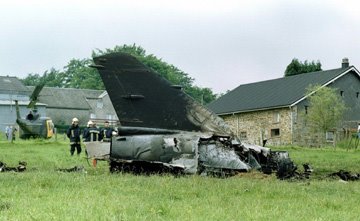
The Russian engine for the SAAF, was as a result of feasibility studies done by the SAAF for a future fighter aircraft. When the MiG 29 was evaluated on paper, the task team realised that the RD-33 Klimov engine of the MiG 29, could work in the Mirage F1 AZ. The first report of such an upgrade appeared in "Flight International" of January 1992. By that time secret negotiations between South Africa and Russia were already underway for a number of months.
The upgrade:
A big advantage of Russian equipment is price and the Russians delivered two RD-33 Klimov engines for installation in an F1 AZ and an F1 CZ. In exchange, a Mirage F1 CZ no 214 was flown to Russia for the fitment and feasibility study of the Russian engine upgrade. The project was therefore researched both in Russia and South Africa at the same time and this reduced the project turn around time. Most of the interfacing and ground tuning of the engine was carried out in Moscow by the Mikoyan and Klimov design bureau. Details were regularly exchanged between the South African and Russian teams to fit the engine also in South Africa.

Local, high technology aerospace company, Aerosud, carried out the Russian engine upgrade. The engine was lengthened and fitted with a new gearbox and designated SMR-95. The AZ converted was No 216 easily distinguished with the longer afterburner section. Initial tests were flown by Rick Culpan of Atlas (DENEL) aviation, during 1994. Later that same year Maj Viktor Parkhomento of the Russian Air Force attended the F1 AZ conversion course and went solo on a SAAF F1 AZ.

The other engine delivered was installed in a Cheetah D no 847. The results were quite surprising, although the new engine only offered 10% more thrust; it was 350kg lighter, but at the same time consuming far less fuel.The performance achieved was very favourable with far less fuel consumption and it seemed that all the F1s would receive the upgrade, with the Cheetahs upgraded at a later date. No 216 was also displayed at SAAF 75 with a distinctive non-French sound. During this time the aircraft received the name "Super Mirage F1 AZ". Although the Mirage F1 was initially known as the "Super Mirage" in France. However, with South Africa entering the international arena once again after the new Government came to power in SA, the arms embargo was scrapped against SA. The SAAF therefore decided to cancel the Russian engine and the new AZ avionics upgrade and rather purchase new fighter aircraft. The Russian engines were removed and both the Super F1 AZ no 216 and Cheetah D no 847 were placed on static exhibit at the SAAF Museum Swartkops. Since then all the F1s have been withdrawn from SAAF service and offered for sale.
Super F1 AZ" display in Russia:
It is believed that a number of foreign buyers started expressing interest in the SA F1s on offer for sale, due to the high price of new fighter aircraft. Apparently, the sale considered, specified that the Russian engine and avionics upgrade form part of the sale. Aerosud & DENEL removed the "Super F1 AZ" & Cheetah D no 847 and placed them on static display at Africa Aerospace & Defence 2000. Around the same time ATE from South Africa completed the avionics upgrade of the Spanish F1s. This avionic upgrade was initially developed for use on the SAAF's AZs. Cheetah D, No 847 went to DENEL and currently stored at AFB Waterkloof. However, the Russians saw potential in the F1s offered for sale and asked Aerosud to display the "Super Mirage F1 AZ" during the MAKS 2001 air show in Moscow. Another advantage is the AA-11 Archer already integrated on the AZ during the V3P trials (1995-1997). This was seen as an excellent co-operation between Russian and South African technology for the export market. Aerosud re-installed the engine and revived the programme. It was completed in record time. No 216 was flown in a huge Antonov to Moscow. But this aircraft was not only on static display it was also displayed in a spectacular aerobatic display routine by one of DENEL's test pilots, Maj Blokkies Joubert, call sign "Cobra". In doing so he became the first Western pilot, to take part in a Russian air show. He was also flying a very unique aircraft, most probably the first Russian powered, Western aircraft, taking part in an air show in Russia. Maj Joubert, said the language was a huge barrier. Because no Western pilot took part in a Russian air show before, the air show controllers didn't speak English. An interpreter was used, but it still proved very difficult in the end. However, the Russians were suitably impressed by the South African and he was subsequently named as one of the top 10 best display pilots. He also received appraisals and a special award as the first Western display pilot, from President Wladimir Putin. Indeed an achievement very few other pilots can put their name to.

Aerosud refined the upgrade on No 216 and the aircraft was displayed in spectacular fashion at Africa Aerospace and Defence 2002. Although a number of rumours are doing the rounds as to the buyer of the ex-SAAF F1s, this has not been confirmed or even if the F1s have in fact been sold. Currently, Aerosud uses three F1s for ongoing tests and project feasibility: No 216 as the flying demonstrator, No 233 as the avionic demonstrator (also used in the Citroen commercial) and No 227 as a static example.
During the Fighter Meet at AFB Makhado on 08 October 2005, the Super F1 AZ was displayed by Blokkies Joubert saw the burner light up beautifully against the failing light. Blokkies Joubert was subsequently awarded the SAAB/BAe trophy for the most professional solo display.
Empresa que modifico el Mirage: http://www.aerosud.co.za/products.htm
Fuente del articulo: IPMS Sudafrica
















